|
In spring 2004 the Darfur crisis came into international focus: thousends of africans fled from their hometown villages in the Sudanese region Darfur because of rioting arabic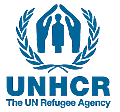 militias and settled down near the border to Chad. Because of attacks on these refugees by the Djandjawid militia the Chadian government and the UNHCR decided to shift the refuges at least 50 km into Chad for raising their security. The UNHCR demanded Germany to assist in this crisis reaction. The German government sent the THW to construct 2 refugee camps. militias and settled down near the border to Chad. Because of attacks on these refugees by the Djandjawid militia the Chadian government and the UNHCR decided to shift the refuges at least 50 km into Chad for raising their security. The UNHCR demanded Germany to assist in this crisis reaction. The German government sent the THW to construct 2 refugee camps.
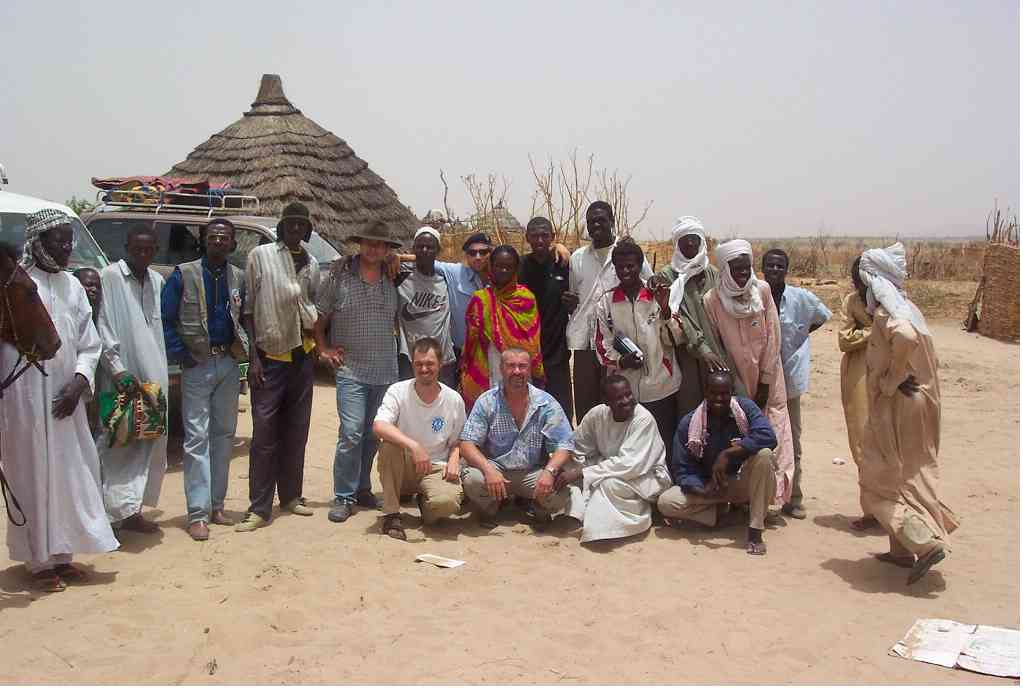 The THW team for the construction of the second camp was made up of 4 men: head of mission, logistician, construction engineer and hydrogeologist. The latter was my main topic. In the field we have been assisted by local employes: an interpreter, 3 drivers, 5 foremen and up to 150 day labourers. The wells have been constructed by a local specialised company. The THW team for the construction of the second camp was made up of 4 men: head of mission, logistician, construction engineer and hydrogeologist. The latter was my main topic. In the field we have been assisted by local employes: an interpreter, 3 drivers, 5 foremen and up to 150 day labourers. The wells have been constructed by a local specialised company.
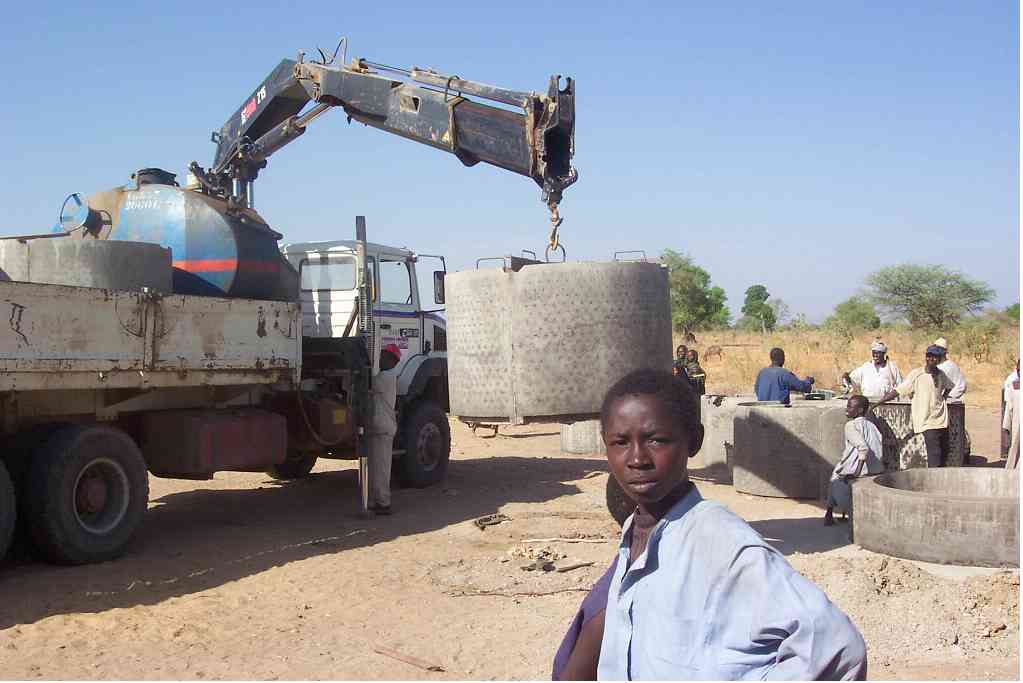
My topic during this one month mission was the reconnaissance and selection of an appropriate site chosen from 4 possible sites offered by UNHCR and local authorities. Definition of sites for well construction and supervision of these works. Geodetic survey of the camp site and planning the sites infrastructure was also my duty combined with the supervision of the local workers. Also the translation French-German/-English during meetings with local authorities and the UNHCR or other relief agencies was one of my topics.
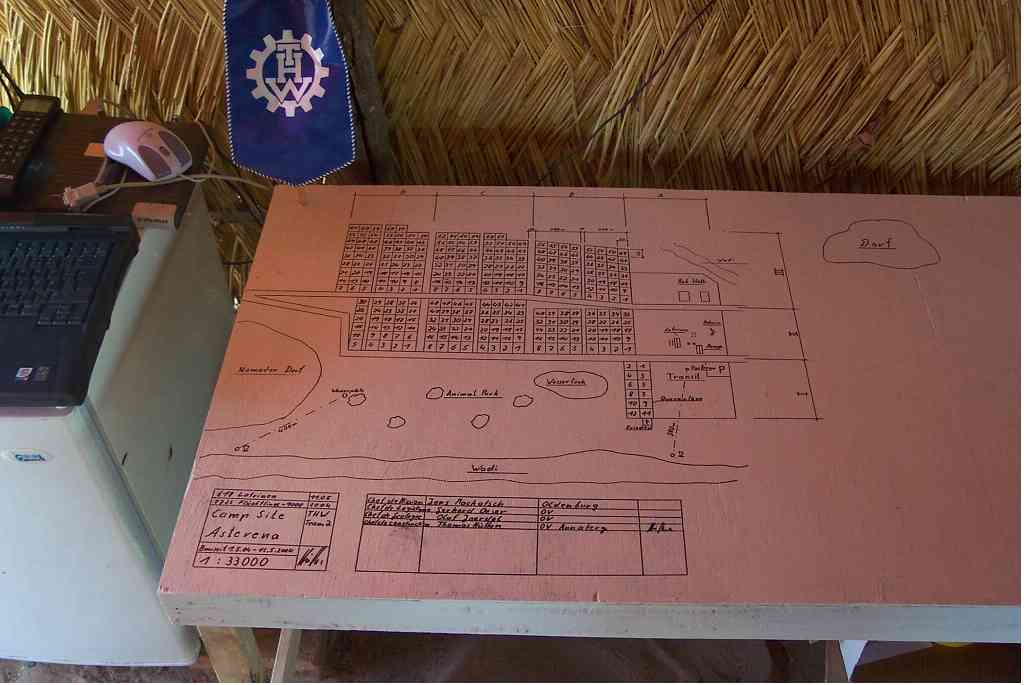 The refugee camp (a map is shown on the left) covered an area of 1km x 2 km designed for up to 12,000 refugees. We subdivided the site by rectangular tracks into fields for administration/service, food storage, living and cattle field. The first two are separated by a wooden fence and contain 2 little brick roundhouses for the administration and several sunroofs for waiting area and service points such as medical screening point and food distribution. Enaugh place for the World Food Program (WFP) rub halls was prepared. The housing areas itself are separated into 317 squares of 50 m containing each 2 latrines to give families enaugh space. The water supply is achieved by 2 wells each connected with a 400 m pipeline to water distribution points next to the camp. One distribution point is equipped with a 20 m³ water cistern. Both wells are equipped with electric pumps and each a generator. These installations maintain the drinking water supply for about 15,000 people so enough for refugees and local habitants. The refugee camp (a map is shown on the left) covered an area of 1km x 2 km designed for up to 12,000 refugees. We subdivided the site by rectangular tracks into fields for administration/service, food storage, living and cattle field. The first two are separated by a wooden fence and contain 2 little brick roundhouses for the administration and several sunroofs for waiting area and service points such as medical screening point and food distribution. Enaugh place for the World Food Program (WFP) rub halls was prepared. The housing areas itself are separated into 317 squares of 50 m containing each 2 latrines to give families enaugh space. The water supply is achieved by 2 wells each connected with a 400 m pipeline to water distribution points next to the camp. One distribution point is equipped with a 20 m³ water cistern. Both wells are equipped with electric pumps and each a generator. These installations maintain the drinking water supply for about 15,000 people so enough for refugees and local habitants.
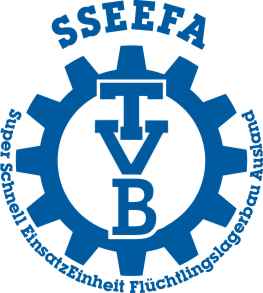 The principal challenge during this mission was to finish the construction well before the rain season due to problems in accessibility. The local roads or better said tracks pass lots of quaddies. These are during most of the year dry riverbeds which are transformed into torrential rivers after rainfall. Time limitations have been our well construction contractor who stated a deadline for the retreat of his crew and material and the necessary time needed for the WFP to fill their rub halls with food for supplying the camp over the rain season. That is why soon we introduced SSEEFA as abbreviation for our team and TVB as our motto. The principal challenge during this mission was to finish the construction well before the rain season due to problems in accessibility. The local roads or better said tracks pass lots of quaddies. These are during most of the year dry riverbeds which are transformed into torrential rivers after rainfall. Time limitations have been our well construction contractor who stated a deadline for the retreat of his crew and material and the necessary time needed for the WFP to fill their rub halls with food for supplying the camp over the rain season. That is why soon we introduced SSEEFA as abbreviation for our team and TVB as our motto.
|

 militias and settled down near the border to Chad. Because of attacks on these refugees by the Djandjawid militia the Chadian government and the UNHCR decided to shift the refuges at least 50 km into Chad for raising their security. The UNHCR demanded Germany to assist in this crisis reaction. The German government sent the THW to construct 2 refugee camps.
militias and settled down near the border to Chad. Because of attacks on these refugees by the Djandjawid militia the Chadian government and the UNHCR decided to shift the refuges at least 50 km into Chad for raising their security. The UNHCR demanded Germany to assist in this crisis reaction. The German government sent the THW to construct 2 refugee camps.
 The THW team for the construction of the second camp was made up of 4 men: head of mission, logistician, construction engineer and hydrogeologist. The latter was my main topic. In the field we have been assisted by local employes: an interpreter, 3 drivers, 5 foremen and up to 150 day labourers. The wells have been constructed by a local specialised company.
The THW team for the construction of the second camp was made up of 4 men: head of mission, logistician, construction engineer and hydrogeologist. The latter was my main topic. In the field we have been assisted by local employes: an interpreter, 3 drivers, 5 foremen and up to 150 day labourers. The wells have been constructed by a local specialised company.

 The refugee camp (a map is shown on the left) covered an area of 1km x 2 km designed for up to 12,000 refugees. We subdivided the site by rectangular tracks into fields for administration/service, food storage, living and cattle field. The first two are separated by a wooden fence and contain 2 little brick roundhouses for the administration and several sunroofs for waiting area and service points such as medical screening point and food distribution. Enaugh place for the World Food Program (WFP) rub halls was prepared. The housing areas itself are separated into 317 squares of 50 m containing each 2 latrines to give families enaugh space. The water supply is achieved by 2 wells each connected with a 400 m pipeline to water distribution points next to the camp. One distribution point is equipped with a 20 m³ water cistern. Both wells are equipped with electric pumps and each a generator. These installations maintain the drinking water supply for about 15,000 people so enough for refugees and local habitants.
The refugee camp (a map is shown on the left) covered an area of 1km x 2 km designed for up to 12,000 refugees. We subdivided the site by rectangular tracks into fields for administration/service, food storage, living and cattle field. The first two are separated by a wooden fence and contain 2 little brick roundhouses for the administration and several sunroofs for waiting area and service points such as medical screening point and food distribution. Enaugh place for the World Food Program (WFP) rub halls was prepared. The housing areas itself are separated into 317 squares of 50 m containing each 2 latrines to give families enaugh space. The water supply is achieved by 2 wells each connected with a 400 m pipeline to water distribution points next to the camp. One distribution point is equipped with a 20 m³ water cistern. Both wells are equipped with electric pumps and each a generator. These installations maintain the drinking water supply for about 15,000 people so enough for refugees and local habitants.
